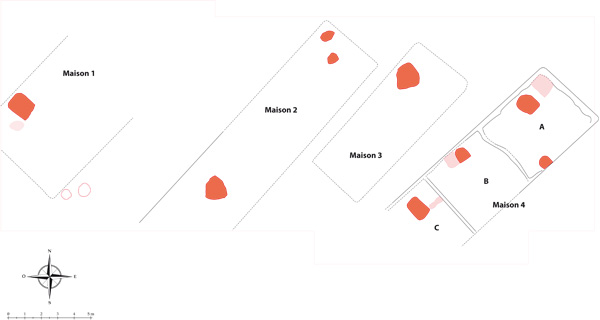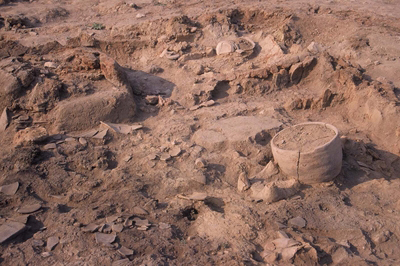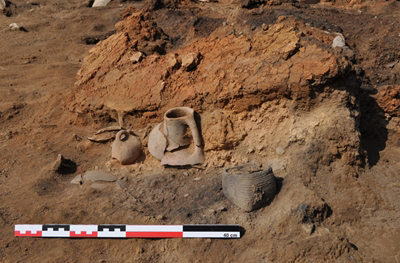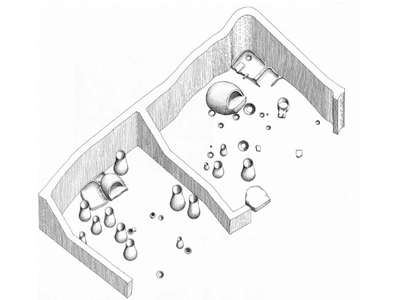Neolithic : The houses
The houses of sector 6

House 1 was partially explored in 1989 and is currently under excavation again. The only room investigated so far measures at least 30 sq.m; an oven was found near the back wall and probably faced the entrance. On the floor around it many items were found (pottery, stone and bone tools) as well as a large quantity of charred fruits and grains, among which were the remains of pressed grapes.
House 2 has not been excavated thoroughly, but includes at least one oven or hearth. The easternmost houses 3 and 4 are the best preserved. House 3 (5x9 m) seems to consist of only one room, with one oven located near the north wall, while house 4, which is slightly bigger (6x11 m), is divided into three rooms by two continuous partitions. The two rooms to the north, Α and Β, are approximately equal in size (25 to 30 sq.m), while room C in the south is only partly preserved. They seem to represent three independent households occupied by three distinct families.


 Each room has its own entrance, probably located in the Southeast, and an oven near the opposite wall — just like the one found in house 1. The three ovens, either elevated or at ground level, have vaulted roofs with semicircular openings, in front of which was a sort of small platform. Houses were also equipped with benches, built next to the oven, and large vessels made of raw clay, often decorated with incisions. The floor was covered with various finds used for everyday activities, especially the preparation and consumption of food.
No pits for the disposal of ashes or waste were found in the houses of sector 6, but features like that, were recorded by J. Deshayes in sector B. The ovens excavated there were almost always elevated, often rectangular in plan with a platform in front of the opening, and usually located in the center of the room. Evidence from the houses of sector 6 allows us to refine those initial observations, while showing the diversity that existed from one building to another within the same settlement.
Each room has its own entrance, probably located in the Southeast, and an oven near the opposite wall — just like the one found in house 1. The three ovens, either elevated or at ground level, have vaulted roofs with semicircular openings, in front of which was a sort of small platform. Houses were also equipped with benches, built next to the oven, and large vessels made of raw clay, often decorated with incisions. The floor was covered with various finds used for everyday activities, especially the preparation and consumption of food.
No pits for the disposal of ashes or waste were found in the houses of sector 6, but features like that, were recorded by J. Deshayes in sector B. The ovens excavated there were almost always elevated, often rectangular in plan with a platform in front of the opening, and usually located in the center of the room. Evidence from the houses of sector 6 allows us to refine those initial observations, while showing the diversity that existed from one building to another within the same settlement.

